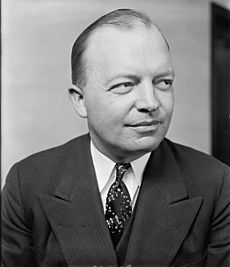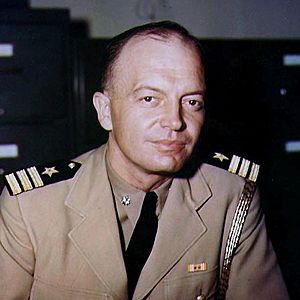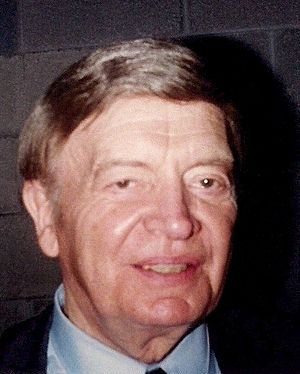Harold Stassen facts for kids
Quick facts for kids
Harold Stassen
|
|
|---|---|

Stassen in 1940
|
|
| Director of the United States Foreign Operations Administration | |
| In office August 3, 1953 – March 19, 1955 |
|
| President | Dwight D. Eisenhower |
| Preceded by | Position established |
| Succeeded by | Position abolished |
| Director of the Mutual Security Agency | |
| In office January 28, 1953 – August 1, 1953 |
|
| President | Dwight D. Eisenhower |
| Preceded by | W. Averell Harriman |
| Succeeded by | Position abolished |
| 3rd President of the University of Pennsylvania | |
| In office 1948–1953 |
|
| Preceded by | George William McClelland |
| Succeeded by | William Hagan DuBarry (acting) |
| Chair of the National Governors Association | |
| In office January 7, 1941 – June 21, 1942 |
|
| Preceded by | William Henry Vanderbilt III |
| Succeeded by | Herbert O'Conor |
| 25th Governor of Minnesota | |
| In office January 2, 1939 – April 27, 1943 |
|
| Lieutenant | C. Elmer Anderson Edward John Thye |
| Preceded by | Elmer Austin Benson |
| Succeeded by | Edward John Thye |
| Personal details | |
| Born |
Harold Edward Stassen
April 13, 1907 West St. Paul, Minnesota, U.S. |
| Died | March 4, 2001 (aged 93) Bloomington, Minnesota, U.S. |
| Political party | Republican |
| Spouse |
Esther Glewwe
(m. 1929; died 2000) |
| Education | University of Minnesota (BA, LLB) |
| Military service | |
| Branch/service | |
| Years of service | 1942–1945 |
| Rank | |
| Battles/wars | World War II |
| Awards | Legion of Merit |
Harold Edward Stassen (born April 13, 1907 – died March 4, 2001) was an American politician. He served as the 25th governor of Minnesota. He was the youngest person ever elected to that job.
Stassen was a strong candidate for president in 1948. He kept running for president and other offices many times throughout his life. Because of this, he became known as a "perennial candidate", meaning someone who runs for office very often.
Born in West St. Paul, Minnesota, Stassen became a lawyer. After college, he was elected as the county attorney for Dakota County, Minnesota. He became Governor of Minnesota in 1938. He even gave a big speech at the Republican National Convention in 1940.
During World War II, he left his job as governor to join the United States Navy. He worked for Admiral William Halsey Jr. After the war, he became the president of the University of Pennsylvania. He held this job from 1948 to 1953.
Stassen tried to become the Republican candidate for president in 1948. He even had the first recorded debate between presidential candidates with Thomas E. Dewey. He also tried for the nomination in 1952 and helped Dwight D. Eisenhower win. After working for President Eisenhower, Stassen ran for many other offices, but he never won another election.
Contents
Early Life and Education (1907–1930)
Harold Stassen was born in West St. Paul, Minnesota. He was the third of five children. His father was a farmer and served as mayor of West St. Paul several times.
Harold was a very bright student. He finished elementary school at age 11 and high school four years later. He went to the University of Minnesota. There, he was a great debater and speaker. He also captained the university's champion rifle team in 1927. He earned his first degree in 1927 and his law degree in 1929. In the same year, he married Esther Glewwe.
Political Career
Starting in Politics (1930–1938)
In 1930, Harold Stassen opened a law office. He then ran for county attorney of Dakota County and won. He started his job on January 5, 1931. Three years later, he became president of the Minnesota County Attorneys' association.
In 1935, Stassen helped create the Young Republicans committee in Minnesota. He was elected its chairman later that year. He pushed for younger members to have a bigger say in the party.
Stassen was a delegate at the 1936 Republican National Convention. In 1937, he gave an important speech at the Minnesota Republican state convention. In October, he announced he would run for governor in 1938.
Serving as Governor (1939–1943)
Harold Stassen became Governor of Minnesota on January 2, 1939. He was the youngest governor in the state's history. One of his first actions was to check how money was being spent in all state departments. He also signed Minnesota's first law about civil service, which helps make sure government jobs are given based on skill, not connections.
In 1939, he organized a meeting about farm problems. Governors from several states attended. They discussed how World War II might affect farming. By the end of 1939, over 80% of people approved of Stassen's work as governor. He even had support from members of other political parties.
During his time as governor, Stassen created the Interracial Commission. This was Minnesota's first civil rights organization. He also appointed an African-American World War I veteran, Samuel Ransom, as his military helper.
World War II Service

Stassen was reelected as governor in 1940 and 1942. He supported President Franklin D. Roosevelt's foreign policy. He encouraged his party to move away from isolationism before the attack on Pearl Harbor.
During his 1942 campaign, Stassen promised that if he won, he would resign to serve in the United States Navy Reserve. He had already joined the Navy as a lieutenant commander. He won the election and kept his promise. He resigned as governor on April 23, 1943, to join the Navy full-time. This was the last time he held an elected office.
He was promoted to commander and joined Admiral William F. Halsey's staff in the Pacific Ocean. He received the Legion of Merit award for his excellent service. After nearly two and a half years, he was promoted to captain in September 1945. He left active duty in November of that year.
While Stassen was serving overseas, other Republican politicians like Thomas E. Dewey gained more political power. After the war, Stassen was a delegate at the conference in San Francisco that created the United Nations. He was one of the U.S. officials who signed the United Nations Charter.
From 1948 to 1953, he was the president of the University of Pennsylvania. He also worked for President Dwight D. Eisenhower from 1953 to 1955. He was the director of the United States Foreign Operations Administration, which handled foreign aid.
Running for President (1944–1964)
Harold Stassen became famous for running for the Republican presidential nomination many times. He tried nine times between 1944 and 1992. He never won the nomination or became president. After 1952, he didn't come close, but he kept campaigning seriously until almost a year before he died.
Because he was the youngest governor and very popular, Stassen was seen as a possible future president as early as 1940. Even though he was too young to be president until 1942, many people thought he had a bright future.
Stassen's best chance to become president was in 1948. He won several early primary elections, which surprised many people. He was a serious challenger to the front-runner, New York Governor Thomas E. Dewey. Dewey even challenged Stassen to a debate before the Oregon Republican primary. This Dewey–Stassen debate on May 17 was the first recorded debate between presidential candidates in the U.S. It was broadcast on the radio across the country.
At the 1948 Republican convention, Stassen finished third in the first two rounds of voting. After that, he and another candidate, Robert Taft, stepped aside. Dewey was then chosen as the nominee. Since 1948, every Republican nominee has been chosen on the first vote.
In 1952, Stassen's home state delegates helped Dwight D. Eisenhower win the Republican nomination. Stassen's delegates switched their support to Eisenhower, helping him defeat Robert A. Taft. Stassen then worked in Eisenhower's government. He was in charge of foreign aid and was a special assistant for disarmament.
Later Life (1964–2001)
After working for President Eisenhower, Stassen continued to run for various offices. He ran for:
- County Attorney of Dakota County (he won in 1930 and 1934).
- Governor of Minnesota four times (he won his first three attempts in 1938, 1940, and 1942, but lost in 1982).
- United States Senate twice (in 1978 and 1994 in Minnesota).
- Governor of Pennsylvania twice (in 1958 and 1966).
- Mayor of Philadelphia once (in 1959).
- U.S. Representative (in 1986).
In 1978, Stassen moved back to Minnesota. He continued to run for president in almost every election until 1992.
When Happy Chandler died in 1991, Stassen became the oldest living former governor of any U.S. state. Harold Stassen died in 2001 in Bloomington, Minnesota, at age 93. He is buried at the Acacia Park Cemetery. The Minnesota Department of Revenue building is named after him.
Religious Life
Stassen was raised as a Baptist and was very active in his church. He was also involved in many other religious groups. In the 1960s, he became known as a liberal thinker. In 1963, as president of the American Baptist Convention, he joined Martin Luther King Jr. in the March on Washington for Jobs and Freedom.
His religious beliefs influenced many of his political ideas. He held important positions in his church and in national church councils. Baptists often remembered him as much for his church work as for his political career. His son, Glen Stassen, became a well-known Baptist theologian.
Political Beliefs
Throughout his life, Stassen was a liberal Republican. This meant he often disagreed with the more conservative members of the Republican Party. For example, he challenged Senator Robert A. Taft, a leader of the conservative group, in Taft's home state during the 1948 Republican primary.
Economy and Workers
During his 1938 campaign for governor, Stassen was against a sales tax. Later in life, he supported a form of universal basic income. This idea would give unemployed mothers with two or more children a set amount of money each month. Stassen also believed in low tariffs, which are taxes on goods imported from other countries. He thought high tariffs were not good for Americans.
As governor of Minnesota, Stassen had good relationships with both labor unions and businesses. He had concerns about the Taft–Hartley Act, a law that required union members to sign papers saying they were not communists.
Foreign Policy
Even though Stassen had called for banning the Communist Party in the U.S., he disagreed with most conservatives on some foreign policy issues. He was against the embargo on Cuba and military action in Vietnam. Instead, he thought both North and South Vietnam should join the United Nations to solve their problems peacefully.
United Nations Support
Stassen was one of the people who helped create the United Nations. He supported it throughout his life. When he died in 2001, he was the last living person who had signed the United Nations Charter.
Military Awards
- Legion of Merit
- Navy Commendation Ribbon
- Asiatic-Pacific Campaign Medal with four battle stars
- World War II Victory Medal
Electoral History

Harold Stassen ran in many elections during his political career. He was elected governor of Minnesota three times: in 1938, 1940, and 1942.
Stassen ran for the Republican nomination for President of the United States in 1940, 1944, 1948, 1952, 1964, 1968, 1980, 1984, 1988, and 1992. In 1940, he was a "favorite-son" candidate from his state. After giving a keynote speech, he supported Wendell Willkie, who became the nominee. His campaigns in 1948 and 1952 were competitive, but his other attempts had little impact.
Stassen also ran many unsuccessful campaigns for other public offices. He ran for Lieutenant Governor of Pennsylvania and twice for Governor of Pennsylvania (in 1958 and 1966). He ran for Mayor of Philadelphia in 1959. He tried twice for the United States Senate from Minnesota (in 1978 and 1994). He also ran for the United States House of Representatives in 1986.
Images for kids



